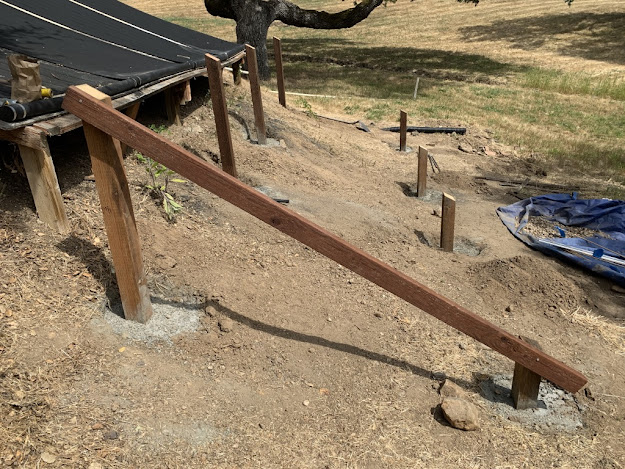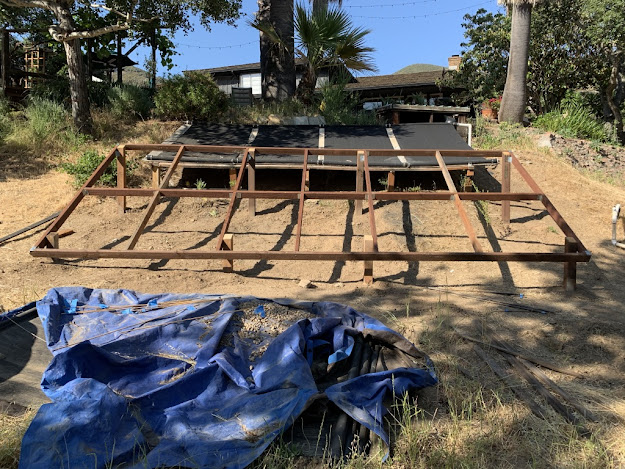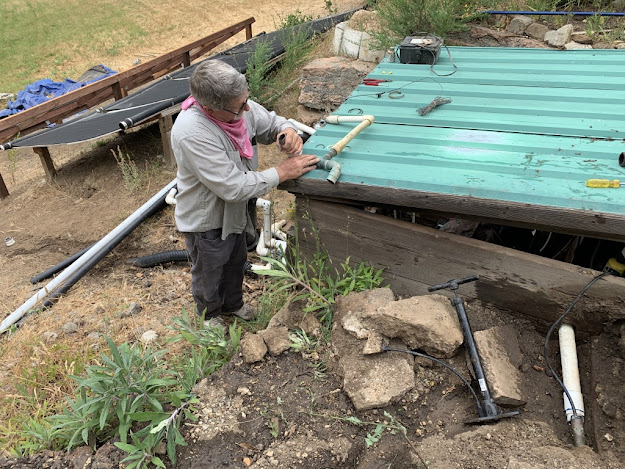The ties that bind
Let the concrete dry overnight.
Just needed to be all connected together and piped to the pump house.
I had pressure treated 2x4's of 12 and 20 foot lengths.
Cut my first frame board at 86 inches and put it on the posts.
Part of my planning included a lot of thinking about how I'd reinforce the frame boards. Sure some large wood screws did a lot but there were a number of places that needed a better solution. Decided to try using metal brackets. I bought a bunch of them.
Worked great.
Things were starting to shape up.
Decided to reinforce the frame further.
This thing is probably stronger than needed. Oh well.
On the brighter side, all that measuring and planning paid off. This thing strapped together quickly.
Got the furring strips set up and I was moving them... one cracked in half. Right at a knot.
Hmm... Fact is, the furring strips hold little weight as part of the frame. So I they didn't need a huge amount of structural integrity. I had a couple extra feet of board so I just cut a piece and bridged the two broken pieces, screwing it all together back to a long, single strip.
You can see the board and the repair below on the finished frame. Second row from the top. Also see my repurposed wood as a center furring strip.
Note the pump house upper left in the photo above.
Rick and I had decided to repipe the thing with larger, 2' black pipes, along with a new pump.
I had yet to lay out the new solar panels but Rick was available to do the pump work so...
First dig out the old intake pipe. Leaky.
Rick working with me. New intake pipe in place but not connected yet.
Mid-surgery. Old pump pulled out. Various fittings, old white pipes, etc. all over. That black number is the pool filter. Still good.
We got the new piping done. New valves too.
Rick came back the next day to check it with me. The solar wasn't quite done but the pool was working fine.
I went back to finishing the array. Layed out the roof panels. Kathleen snapped this one of me working on the panels.
The corrugated roofing was a good call. Easy to install. Made laying the solar panels out quite a straightforward process. Used screws with rubber washers to hold the panels down. Won't crack them.
The solar panels connect with clamps and rubber piping connectors. I used more metal brackets to screw the clamps to the frame. Mostly copied how it was secured in the old array.
I was done that afternoon.
Next day Rick and I laid out the new pipes. Here's the water line coming down from the pump house.
I also refurbished the old array.
Dug out a bit of rot on the old plywood. Reseating the panels to the rack with new braces. Tightened pipe connectors. Reinforcing some old posts. I also strapped the panels down to the rack with special panel strapping. It makes them wind resistant during winter storms. One reason the old rack fell apart is the wind literally would pull the panels up off the rack during a storm.
The two arrays are now down.
Here's how it all works together:
The water comes down from the pump house along that black pipe on the ground and enters the array near post 8.
It is pumped up through the new array, exits near post 1 and cross connects to the old array.
Then the water runs through the old array and water now warmed by the sun comes out back at the top right of the old array and goes back into the pump house to the pool.
The finished system is working like a charm. By mid-afternoon it's kicking out 85 degree water.


















Comments
You still have all eleven fingers, right?